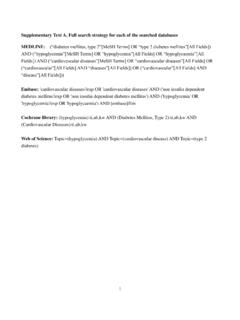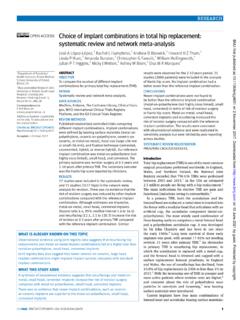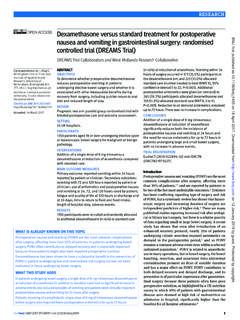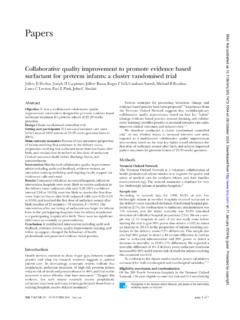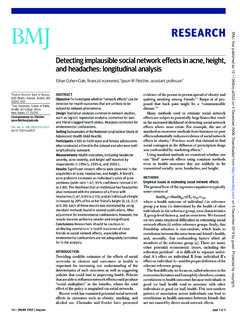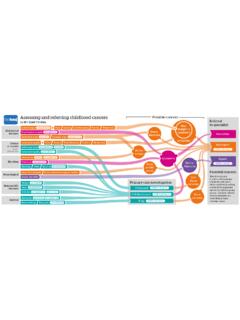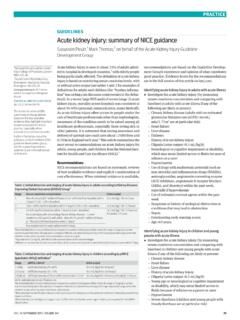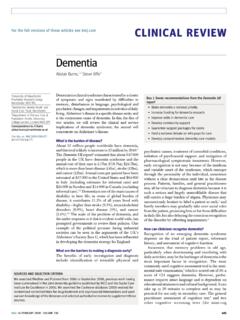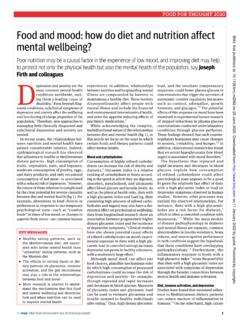Transcription of Diabetic foot - BMJ
1 CLINICAL UPDATES. Diabetic foot BMJ: first published as on 16 November 2017. Downloaded from on 31 January 2022 by guest. Protected by copyright. Satish Chandra Mishra,1 Kunal C Chhatbar,2 Aditi Kashikar,3 Abha Mehndiratta4. 1. Department of Surgery, Bhabha Atomic Research Centre Hospital, Mumbai, India 2. KHM Hospital, Mumbai, India 3. Seth Gordhandas Sunderdas Medical College and King Edward Memorial Hospital, Mumbai, India 4. Global Health and Development Group, Imperial College London, St Mary's Hospital, London, UK. Correspondence to: A Mehndiratta Foot disease affects nearly 6% of people with Sources and selection criteria diabetes1 and includes infection, ulceration, or This clinical update is based on recommendations in the destruction of tissues of the It can impair standard treatment guideline, The Diabetic foot: prevention patients' quality of life and affect social participation and management in India 2016, published by the Indian and Between and of Ministry of Health and Family A multidisciplinary patients with Diabetic foot require an guideline development group consisting of surgeons, primary Most ulcers can be prevented with good foot care care practitioners, and a patient representative developed and screening for risk factors for a foot at risk these guidelines, with inputs from experts in diabetes, Diabetic foot rehabilitation, and vascular surgery.
2 The group of We provide an update on the included representation from rural and urban India, and prevention and initial management of Diabetic foot in public and private sectors. primary care. The guideline development group selected recommendations from the National Institute for Health and Care Excellence What causes Diabetic foot? clinical guideline 19. Diabetic foot problems: prevention Uncontrolled diabetes contributes to the development of and management. Updated 2016, International Working neuropathy and peripheral arterial disease by complex Group on the Diabetic Foot guidance on the prevention of metabolic Loss of sensation caused by foot ulcers in at-risk patients with diabetes 2015, National peripheral neuropathy, ischaemia due to peripheral Institute for Health and Care Excellence. Peripheral arterial arterial disease, or a combination of these may lead disease: diagnosis and management. Guideline 147, 2012, to foot ulcers.
3 A systematic review (78 studies from and Infectious Diseases Society of America clinical practice 84 cohorts) reports a prevalence of for guideline for the diagnosis and treatment of Diabetic foot diabetes related peripheral neuropathy and infections, 10 21 32 Some recommendations were for diabetes related peripheral arterial Figure 1 adopted unchanged, whereas others were adapted taking into account the challenges of a low resource setting, such depicts factors that contribute to foot complications. as availability of public and private health infrastructure, Diabetes is also implicated in Charcot arthropathy, equipment, staffing, and current capacity at different levels which involves progressive destruction of the bones, of care. joints, and soft tissues, most commonly in the ankle and foot. Diabetes related Charcot's arthropathy has a reported prevalence between and 13%, but there are no high quality epidemiological studies on In low and middle income countries barefoot walking, Charcot's 8 A combination of neuropathy, abnormal lack of awareness, delay in seeking care, and shortage of loading of foot, repeated micro trauma, and metabolic trained healthcare providers and foot care services are abnormalities of bone leads to inflammation, causing common factors that add to the burden of foot disease.
4 Osteolysis, fractures, dislocation, and How is it diagnosed? A thorough foot examination is important to detect the disease early. Screening for peripheral neuropathy and What you need to know peripheral arterial disease can help identify patients at risk Diabetic foot can be prevented with good of foot ulcers. A history of ulcers or amputations and poor glycaemic control, regular foot assessment, glycaemic control increase the risk. appropriate footwear, patient education, and Assess the patient's general condition for signs of early referral for pre-ulcerative lesions toxicity or sepsis such as feeling unwell, looking sick, Examine the feet of people with diabetes showing abnormal behaviour, circulation, or respiration, for any lesions and screen for peripheral with or without fever. Examine the feet at each follow-up neuropathy and peripheral arterial disease, visit for active disease such as ulceration or gangrene which can lead to injuries or ulceration Refer patients with foot ulceration and signs of infection, sepsis, or ischaemia immediately to a How patients were involved in the creation of P.
5 Specialised Diabetic foot centre for surgical care, this article revascularisation, and rehabilitation No patients were involved in the creation of this article. the bmj | BMJ 2017;359:Supp 1 1. CLINICAL UPDATES. Peripheral arterial disease Ischaemia BMJ: first published as on 16 November 2017. Downloaded from on 31 January 2022 by guest. Protected by copyright. Loss of protective sensation Unnoticed repetitive trauma Neuropathy Foot deformity/Joint rigidity Improper loading, abnormal plantar pressures ULCER. Dry skin and decreased integrity Cracks and fissures in skin Barefoot walking, improper footwear Lack of education to health providers Lack of education to patients Lack of foot protection service GANGRENE. Neuropathy Trauma Inflammatory reaction Infection Charcot foot (osteoarthropathy) Foot deformity AMPUTATION. Fig 1 | Risk factors and mechanism for foot ulcer and amputation (fig 2). Look for lesions such as fungal infection, cracks pain, which suggest peripheral arterial and skin fissures, deformed nails, macerated web spaces, Palpate the posterior tibial artery and dorsalis pedis calluses, and deformities such as hammer toes, claw artery in both feet and record pulsations as absent or toes, and pes cavus, which increase the risk of ulceration (fig 3).
6 Feel the temperature of the feet with the dorsum The ankle brachial index is an adjunct measure to of your hand. A cold foot might suggest ischaemia, and diagnose peripheral arterial 21 It is the ratio of increased warmth with redness and swelling might the highest systolic blood pressure at the ankle (dorsalis suggest inflammation such as acute Charcot foot or pedis artery or posterior tibial artery) to the systolic cellulitis. blood pressure at the arm, and is measured using a Doppler See box 2 on grading the severity of Peripheral neuropathy obstruction. Measurement of the ankle brachial index The aim of screening is to identify patients with loss is user dependent. People with diabetes can often have of protective sensation in the feet. Most guidelines falsely raised ankle brachial index levels as a result of poor recommend the 10 g monofilament for neuropathy compressibility from calcified Furthermore, assessment (fig 4) in people with 10 This availability of equipment, time constraints, and lack of monofilament exerts a 10 g buckling force when it training are reported as major barriers to ankle brachial bends.
7 An inability to sense a 10 g pressure is the current index testing in primary consensus definition of loss of protective sensation. The On the basis of this initial assessment, patients can test is portable, cheap, and easy to perform (box 1).12 be categorised as having a low, moderate, or high risk of 15. Despite the widespread use of the monofilament test, Diabetic foot (see fig 5).9. its accuracy in diagnosing neuropathy is The test may be combined with another test to screen for neuropathy, such as a biothesiometer or a graduated tuning fork (Rydel Seiffer) to assess vibration perception 18. Peripheral arterial disease Ask for a history of intermittent claudication and rest Fig 3 | Hammer toe deformity with callus and ulcer. Hammer toe is caused by weakened muscles in the foot. The joint connecting the foot with the toe bends upwards and the joint in middle of the toe bends downwards towards the floor. This results in the toe curling Fig 2 | Gangrene and ulcer in foot at high risk (previous toe under the foot and being subjected to excessive ground reaction amputation) forces during walking.
8 2 BMJ 2017;359:Supp 1 | the bmj CLINICAL UPDATES. Box 2: Ankle brachial index The severity of peripheral arterial disease is interpreted22: Normal BMJ: first published as on 16 November 2017. Downloaded from on 31 January 2022 by guest. Protected by copyright. Mild obstruction Moderate obstruction < Severe obstruction > Poorly compressible vessel death, and reduces hospital admissions and Glycaemic control Early and good glycaemic control is effective in preventing neuropathy but there is a lack of studies to show that Fig 4 | Monofilament test: testing sites and application. The nine plantar sites are the distal great toe; third toe; fifth toe; first, third, and fifth metatarsal heads; medial foot, lateral glycaemic control reverses Discuss optimal foot, and heel; and one dorsal site blood sugar and glycated haemoglobin (HbA1c) targets with patients and monitor these as per standard guidelines How can it be prevented? for diabetes care to prevent or slow the progression of Regular foot examination peripheral 28.
9 The suggested frequency for follow-up is based on expert consensus (fig 5). For people at low risk, continue annual Patient education foot assessments as they could progress to moderate or Offer people with diabetes or their caregivers, or both, oral high risk. Emphasise the importance of foot care and and written information on: monitoring glycaemic control. The importance of blood glucose control and modifiable More frequent follow-up is advised in patients at cardiovascular risk factors such as diet, exercise, body moderate or high risk, such as those with a foot deformity weight, and cessation of smoking. or with a diagnosis of peripheral neuropathy or peripheral The importance of foot care and advice on basic foot arterial disease at initial assessment. Repeat testing for care (see box 3). While offering advice consider the neuropathy is not necessary if diagnosed previously. patient's cultural practices and religious beliefs as well Neuropathy reversal is not established in studies.
10 A quick as social and family support. inspection for a breach in skin integrity or ulceration The person's current risk of developing a foot problem. should suffice. Patients with asymptomatic peripheral When to seek professional help and who to contact in arterial disease may be followed up in primary care and foot emergencies. managed as in guidelines for peripheral arterial Evidence for the effectiveness of patient education on Refer patients with calluses and deformed toe nails to foot care is lacking. A Cochrane review of 11 randomised preventive podiatry services for basic nail and skin care, controlled trials concluded that brief foot care education including debridement of calluses. Timely referral to foot alone does positively influence patient knowledge protection services for control of risk factors in patients and behaviour in the short term, but it is ineffective in with diabetes prevents infection, gangrene, amputation, or preventing Diabetic foot ulcers.
